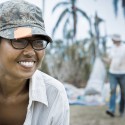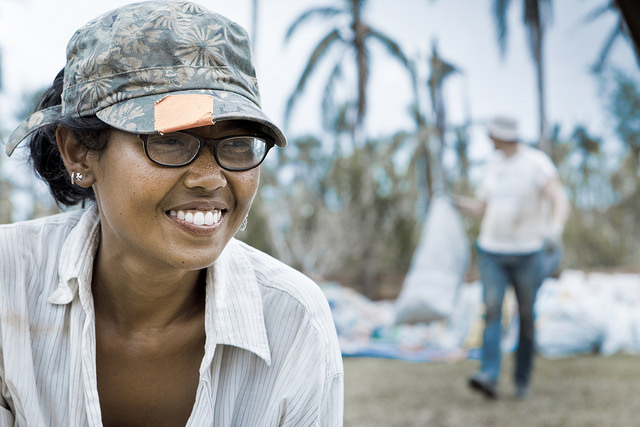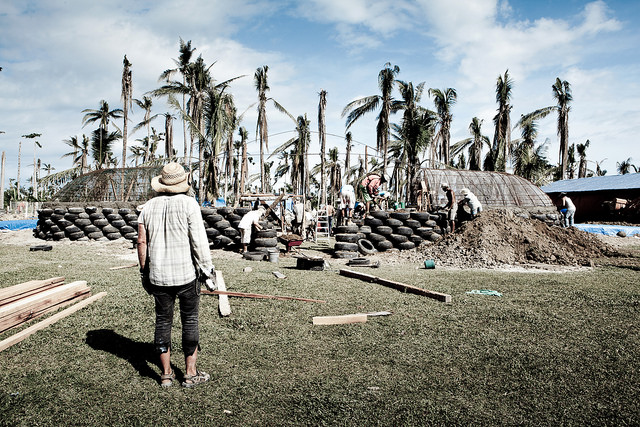Maria Marasigan, 35, New York, USA
So why are you here?
In all the years that these typhoons have been happening in the Philippines, there still isn’t a system, or some kind of preparedness, or a change in how rebuilds happen and what relief is like here. The government supports the people in a very hand out, reactive, short-term way.
Having done the Earthship internship in November, I saw how waste is used for housing, the systems of water catchment, solar, and all of these things that are really looking at the long-term and self-sufficiency. Having less dependency on a government that doesn’t really serve you. Not just here in the Philippines, but everywhere, all over the world, including the United States. After disasters like Katrina and Sandy, people are still waiting for relief when they should already be rebuilding, and that still isn’t happening.
I know you’re not an engineer, but does it seem like this sort of structure is more likely to actually withstand a typhoon than what they’re building around here?
I do. Because of the materials being used. Each of those tires weighs three hundred pounds versus coco lumber and these thin sheets of tin that are on their roofs. The school that’s right there is standing still, but the roof has been taken away. Looking out the window from the airport, lots of concrete buildings that are square have fallen apart.
Walking around out here in the jungle I’ve seen plenty of concrete houses crumbled.
There are some signs in Barangay Hall of like, ‘Here’s how you rebuild,’ and it shows a transitional home, moving into a permanent home, but it’s still the same materials, just bigger. Not really looking at whether this will withstand a disaster so that when the next disaster comes the locals won’t have to rebuild again. Or at least you have to rebuild less of it.
Rebuilding every single year, you think about the costs of that, and investing in something for the long term. Maybe it’s actually the same price. So just do the labor once and live your life. Instead of struggling every single time when you’re already struggling on a daily basis.
The hard part for somebody around here is that initial investment. There’s not a Batug bank willing to loan them twenty thousand American dollars.
Right. Realistically, when you put all the numbers down, no. I don’t think anybody’s going to build that Windship. To speak honestly.
But Earthship does have another model that is residential, that uses almost no cement, and can use the coco lumber and bamboo. But that’s not what was built for this round. I also think that’s okay. Everything is a process and it takes a while.
And this is going to be used for the community as an evacuation area and also classrooms?
Classrooms and also a training center for some of the different barangays around. Earth Village wants to have workshops.
To transition a little bit, we had Hurricane Sandy recently. It devastated much of the American East Coast which is hurricane prone just like this. Do you think, or do you hope, that you’ll start to see more designs like the Windship? I mean, we design cars to be aerodynamic. Why not houses? At least, in that area, or in the Midwest where we have tornados. Can you see that happening?
I definitely can see that happening. Especially when people put that price tag on it. Everyone works around money and cost. If you’re going to put up a hotel, you want it to last there for a long time. You also want to be able to tell your tourists that it’s a safe place to stay. Maybe it helps their insurance company to be like, I have these systems in my building similar to the Windship so there’s going to be less cost for my insurance premium. I can see it. I can see it functioning. It’s just a matter of people taking it on.
They have to embrace it.
Being innovative enough to not go, what can I build the fastest and make the quickest money. And I think there’s starting to be a shift. Even here, within the volunteers and visitors who have come. Governmental officials passing by. There’s interest. It’s just turning that interest into, what they’re actually going to support and what they’re actually going to do.
There was a guy named Peter Barkhammar here. I don’t know if you met him.
I was just about to ask you about him.
That project is amazing, primarily because it has full governmental support and land. Here in the Philippines, land is a big issue.
Will you explain what the project is that Peter Barkhammar has proposed?
I know very little, but that an organization called Eco Regions Indonesia wants to build a Windship/Earthship community in Indonesia and have it connect to livelihoods of people there by making it an eco-tourist area. And it’s really being pushed by the Indonesian government, and I don’t even know how many hectares of land are being provided already in order to do that.
Editor’s Note: Peter Barkhammar is Co-Founder of Eco Regions Indonesia. Visit the site for more information.
What do you think it’s going to take in the States for people to stop perceiving this as just a hippy pipe dream and see it as a reality?
I think if they just went to Taos and stayed in a nightly rental. To see how beautiful an Earthship is and how functional it is, and in comparing it to their own homes. Again, bringing it back to the money, you do not have to pay for air conditioning. You do not have to pay for heating. You do not have to pay for lighting.
Also, not having it be the two extremes of like, I live in an urban environment apartment box that has this huge carbon footprint. Or in the middle of the desert. Which is how I think people look at it. We can have this Earthship in the middle of New York City.
I do wonder about affordable housing. When you have multiple families in one building and you have an Earthship that takes a lot of space, how does that function? What are the parts of this that you can take and add into what already exists? Because we’re not trying to knock down what already exists to build something new.
Okay. Last subject. What do you think of the Earthship crew?
I think they’re awesome. I think they live their work. A lot of them live in houses that they’ve built themselves off of this. And they travel around the world because they want to spread the knowledge on it.
Something that I really liked about meeting Mike Reynolds for the first time… It was in an Earthship talk. He just talked about failure. That everything he’s done has been built off of forty years of failure, and not being embarrassed by that. Because he took risks to try things.
When everyone asks these questions about, well what about the money, or how are people going to do this afterwards? We think about all the things that are blocking us and Mike’s like, you just gotta go try it. Just do it. You’re going to make mistakes.
I love that the Earthship crew have come here. A lot of people don’t know it, but they’re not pushing this on anybody. They’ve been asked to come here because of the ideas that they have. The model that they have here is not something that is set in stone forever as THE answer.
Here is a sample of something. Take what you want. Leave what you want. And that’s it. And if you have suggestions for improvement, let’s begin that conversation.
But let’s try. There’s an expression my girlfriend likes to use. Don’t let the perfect be the enemy of the good.
Okay. I’ve never heard that, but that’s exactly it. Yeah. That holds you back from actually doing something. Doing anything.
Be sure to catch the rest of the series!
- Part One: Michael Reynolds, Creator of Earthship Biotecture
- Part Two: Leo, Olav and Zoe, Windship Volunteers
- Part Three: Hui-Chien and Josh, Windship Volunteers
- Part Four: Florian Becquereau, Founder of Earthship Seattle
- Part Five: John Craig, Christina and Hendry, Windship Volunteers
- Part Six: Andrea Roa Buco, Community Activist and Native of Barangay Batug
- Part Seven: Maria Marasigan, Community Organizer and Earthship Activist



